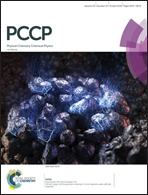Unraveling the effects of amino acid substitutions enhancing lipase resistance to an ionic liquid: a molecular dynamics study†
Abstract
Understanding of the structural and dynamic properties of enzymes in non-aqueous media (e.g., ionic liquids, ILs) is highly attractive for protein engineers and synthetic biochemists. Despite a growing number of molecular dynamics (MD) simulation studies on the influence of different ILs on wild-type enzymes, the effects of various amino acid substitutions on the stability and activity of enzymes in ILs remain to be unraveled at the molecular level. Herein, we selected fifty previously reported Bacillus subtilis lipase A (BSLA) variants with increased resistance towards an IL (15 vol% 1-butyl-3-methylimidazolium trifluoromethanesulfonate; [Bmim][TfO]), and also ten non-resistant BSLA variants for a MD simulation study to identify the underlying molecular principles. Some important properties differentiating resistant and non-resistant BSLA variants from wild-type were elucidated. Results show that, in 15 vol% [Bmim][TfO] aqueous solution, 40% and 60% of non-resistant variants have lower and equal probabilities to form a catalytically important hydrogen bond between S77 and H156 compared to wild-type, whereas 36% and 56% of resistant variants show increased and equal probabilities, respectively. Introducing positively charged amino acids close to the substrate-binding cleft for instance I12R is beneficial for the BSLA resistance towards 15 vol% [Bmim][TfO], likely due to the reduced probability of [Bmim]+ cations clustering near the cleft. In contrast, substitution with a large hydrophobic residue like I12F can block the cleft through hydrophobic interaction with a neighboring nonpolar loop 134–137 or/and an attractive π–π interaction with [Bmim]+ cations. In addition, the resistant variants having polar substitutions on the surface show higher ability to stabilize the surface water molecule network in comparison to non-resistant variants. This study can guide experimentalists to rationally design promising IL–resistant enzymes, and contribute to a deeper understanding of protein–IL interactions at the molecular level.



 Please wait while we load your content...
Please wait while we load your content...